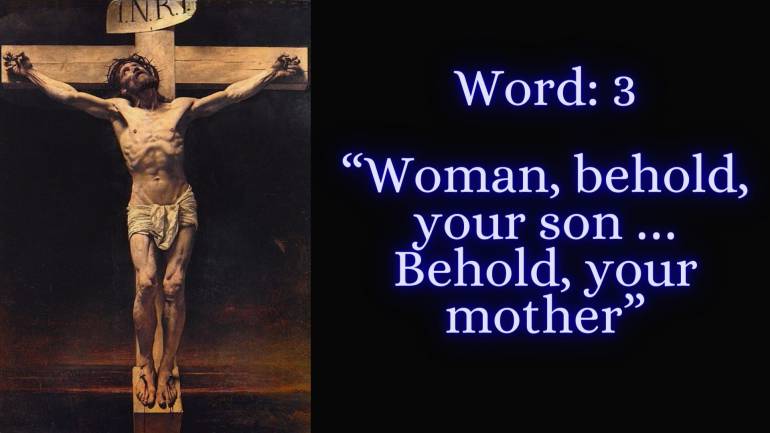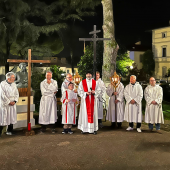The SEVEN Last Words of Jesus. Word: 3 - “Woman, behold, your son … Behold, your mother”

A. Text: John 19: 25–27
“Standing by the cross of Jesus were his mother and his mother’s sister, Mary the wife of Clopas, and Mary of Magdala. When Jesus saw his mother and the disciple there whom he loved, he said to his mother, “Woman, behold, your son.” Then he said to the disciple, “Behold, your mother.” And from that hour the disciple took her into his home.”
B. Exegesis:
1. “… his mother and his mother’s sister, Mary the wife of Clopas, and Mary of Magdala”
John 19,25 contrasts soldiers and women. The soldiers are occupied with sharing Jesus’ clothes whereas the women are watching and waiting with devotion and prayer.
2. “Standing by the cross of Jesus were his mother … and the disciple there whom he loved”
In the Marcan or Matthean tradition, the women who followed Jesus watched from afar; and none of the male disciples was present, for they had fled.
John’s picture is quite different. Not only are the women placed at the foot of the cross, but the mother of Jesus is included among them, together with the beloved disciple.
The mother and the beloved disciple meet at last at the moment of Jesus’ death. They are two figures whom John names only by title (2,1: at Cana). Each was a historical person, but the evangelist is not interested primarily in their historical identity; he is interested in their symbolism and hence, they are named only by title, “his mother … the disciple whom he loved.”
3. “Woman, behold, your son … Behold, your mother”
The scene is interpreted both literally and symbolically.
a. The dying Jesus, out of concern for His ‘natural mother’, gives her to the care of the ‘beloved disciple.’ That is the literal interpretation.
b. We can interpret the scene symbolically as well:
i. It can be interpreted in the light of the Cana story in John 2, since on both occasions, the mother of Jesus is present; the address ‘woman’ is found; and the ‘hour’ is mentioned. Now the hour has come: “After this, aware that everything was now finished …” (19,28).
At Cana, her family's request was rebuked. But now she is given a role as the mother of Christians, personified by the beloved/ ideal disciple. The disciple also becomes a son of Jesus’ natural mother and so a brother of Jesus.
The Johannine community – a community of preeminent disciples – is already in existence at the cross. The cross becomes the birthplace of the Church.
ii. It can also be interpreted in the light of the upper room in John 13, since on both occasions, the beloved disciple is present and the ‘hour’ is mentioned.
iii. The Mother of Jesus could be, when the context of the whole Bible is taken into account, Israel or Lady Zion, the People of God to whom the Messiah is born.
iv. The Mother of Jesus could also be Eve, the ‘woman’ of Genesis 2,23 and her offspring.
v. Mary represents those seeking salvation. Now she is supported by the disciple who interprets Jesus’ revelation.
vi. Jewish and Gentile Christianity are reconciled.
vii. Israel, represented by the mother of Jesus and the Christian community, represented by the beloved disciple are reconciled.
viii. The Mother and the Beloved Disciple represent the new community, the Church in different ways. The Mother represents the Church that begets new children. The Beloved Disciple represents the Church as a community of loving disciples.
C. Application:
4. On the cross Jesus addresses His Mother as “woman.” It is quite strange. At the wedding feast of Cana too He addressed her as “woman.” Hence there is a symbiosis between Cana and Calvary.
i. At Cana, Jesus performed the miracle of changing water into wine. But that miracle was only a symbol, a foreshadowing of the greater miracle He would do at Calvary.
ii. At Cana, Jesus performed the miracle at the request of His Mother. On Calvary, He gives her as the Mother of the Beloved Disciple.
iii. The miracle of Cana brought immense but ‘temporary’ joy to the guests. But the miracle at Calvary would bring immense and ‘lasting’ joy to people.
5. The Beloved Disciple is the symbol of all the disciples loved by Jesus. They are you and me and all Christians.
What a great gift and wonder it is for Jesus to give His own Mother to be our Mother, the Mother of all Christians. Eve, the first woman of the Bible was the mother of all living, “And Adam called the name of his wife/ woman Eve, because she was mother of all living” (Genesis 3,20). The New Eve, addressed by Jesus as “woman” is the Mother of all the new living, the disciples of Jesus. They become now her children.
The Mother and the Disciple at the foot of the cross thus represent the new community of Jesus in the world after Jesus’ departure.
6. The Mother and the Beloved Disciple represent the new community, the Church in different ways. The Mother represents the Church that begets new children. The Beloved Disciple represents the Church as a community of loving disciples.
Mary as the symbol of the Church not only begets children but also teaches her children like a good mother. Mary would have taught Jesus her Son as a child the will of the Father to accept it however difficult it may be. Standing by the cross of Jesus she puts into practice in her life what she taught Jesus. She is accepting the will of the Father even up to the cross. What more sorrow for the Mother to see her only Son hanging on the cross before her eyes? But it was God’s will both for the Son and the Mother.
The Church then as the mother and teacher must model herself after Mary. The best way of teaching is by example. The Church as mother and teacher consists of Pope, bishops, priests, deacons, religious, parents, teachers, etc., those who have some authority in the Church. What we teach others we must, first of all, practise in our own lives, as Mary did. Only if we are ready to follow Jesus in the way of the cross even up to Calvary can our teaching be effective. If we live our mothering and teaching vocation truly, this sincere living can be a way of the cross and an effective influence on others.
7. The Church is also represented by the Beloved Disciple standing by the cross of Jesus. He represents all of us, beloved disciples and believers in Jesus. The main characteristic of this disciple is that he stood by Jesus on the cross when all the other male disciples had fled. For the disciples, it was easy to be with Jesus when he was popular, working miracles, etc – in moments of glory. But the real test of discipleship is when we are with Jesus in the difficult moments of life.
Are we ready to do so? Or do we run away from Jesus at the difficult moments of life and choose our easy worldly way? That is the real test of our discipleship.
8. May the Mother of Jesus and the Beloved Disciple standing by the cross of Jesus be our model and example! If we stand by Jesus at the cross, the dying Jesus will never let us down. May we receive strength from Him as the Mother and the Disciple did, because as for Jesus and even for us, the Church, the cross is the only way of life!
Radio Veritas Asia (RVA), a media platform of the Catholic Church, aims to share Christ. RVA started in 1969 as a continental Catholic radio station to serve Asian countries in their respective local language, thus earning the tag “the Voice of Asian Christianity.” Responding to the emerging context, RVA embraced media platforms to connect with the global Asian audience via its 21 language websites and various social media platforms.














